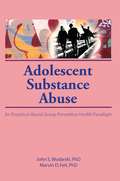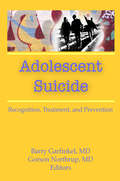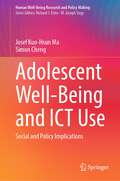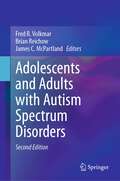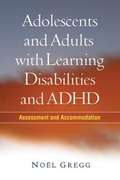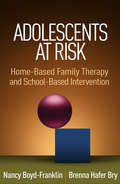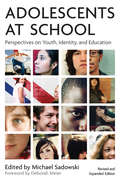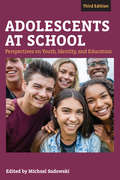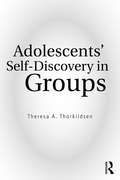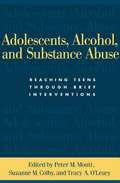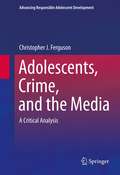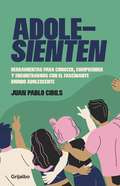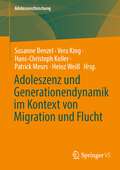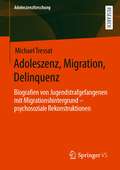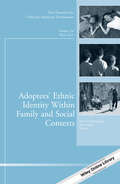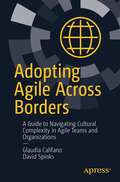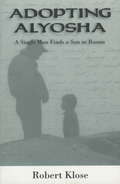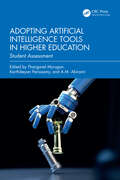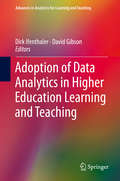- Table View
- List View
Adolescent Substance Abuse: An Empirical-Based Group Preventive Health Paradigm
by John S Wodarski Marvin D FeitHere is a comprehensive review of adolescent substance abuse issues and an expansive, empirically based curriculum for school-based programs to teach adolescents about the dangers of drugs and alcohol. The abuse of alcohol and other drugs among young people is a problem of alarming scope and gravity. Adolescent Substance Abuse explores the multiple forces which impact adolescents and can push them toward drug and alcohol abuse.Adolescent Substance Abuse proposes means by which to effect macro-level change in societal norms and values regarding substance abuse. The authors describes in detail an effective means of teaching adolescents about drugs and alcohol using an empirically based teaching method called Teams-Games-Tournaments (TGT). TGT was developed through extensive research on games used as teaching devices. It uses small groups as classroom work units and capitalizes on peer influence by using peers as teachers and supporters. The book explains an effective curriculum which utilizes the TGT approach and provides a program for parents. The curriculum is unique in that it is anchored in empirical data and delivered via adolescent peer groups. Adolescent Substance Abuse addresses other issues pertinent to the reduction of adolescent substance abuse by exploring subsystems of change, including school and peer group environments, home and family, the media, community movements, and business and industry. The book is a great source of innovative ideas for beginning and expert counselors, social workers, mental health professionals, school psychologists, and others who want to prevent adolescent abuse of drugs and alcohol.
Adolescent Suicide: Recognition, Treatment, and Prevention
by Barry GarfinkelInform yourself with thorough and accurate knowledge about the incidence of adolescent suicide. Adolescent Suicide serves to correct erroneous conceptions--held by the public and professionals--about the nature of suicidal behavior among the young, thereby promoting the opportunity for more prompt and effective evaluation and management of potentially fatal incidents. In this landmark volume, authorities address the problem of suicide among adolescents, which has emerged in recent years as a significant public health problem. In-depth discussions of the epidemiology and behavioral characteristics of youth who attempt and complete suicide, risk factors, methods of death, circumstances of the suicidal act, and reasons for the dramatic increase in the phenomenon provide social workers, educators, psychologists, and psychiatrists with systematic information that can be used in both prevention and intervention efforts. There is also a wealth of valuable material here on school-based suicide prevention programs, strategies for managing and counseling the relatives, peers, and classmates of individuals who have committed suicide, and coping with suicide in residential treatment centers.
Adolescent Well-Being and ICT Use: Social and Policy Implications (Human Well-Being Research and Policy Making)
by Simon Cheng Josef Kuo-Hsun MaIn this book, the authors expertly examine the issue of adolescent well-being in the light of their exposure to and use of information and communication technologies (ICTs) at school and home. The authors discuss a new form of inequality especially noticeable among youth, which is, digital inequality/divide, created through rapid developments in ICT. They analyze the relation between digital divide and educational inequality among youth, describe patterns of social exclusion from technology and education, and discuss related policies in industrialized nations to see how well-being issues can be addressed in this context. Comparing results based on nationally representative and internationally comparative datasets across 28 countries, the authors ask how and why the benefits accruing from ICT are substantially greater for some adolescents, but apparently smaller for others and how such differences may be reduced. They provide policy suggestions that are broadly based in the fields of well-being, secondary education, and technology use. This book is of interest to researchers and students of quality of life and well-being studies and a wide range of social science and education disciplines, including the sociology of education, media sociology, sociology of childhood and adolescence, communication studies, and science and technology education.
Adolescents and Adults with Autism Spectrum Disorders
by Fred R. Volkmar Brian Reichow James C. McPartlandThe second edition of this book examines the numerous research and practice advances with regard to adolescents and adults with autism spectrum disorders (ASD). Expert contributors offer cogent reviews of complex issues, from education to employment, leisure activities to illegal behaviors, mental health issues to medical health concerns. The volume explores the latest findings in key areas, such as psychosocial and residential treatments, social skills programs, epidemiology, the impact of ASD on families. The book focuses on areas of research and practice that require improved models of assessment, current data, new interventions, and increased support services. Key areas of coverage include: Transition from high school to adulthood for adolescents and young adults with ASD. Innovative programming to support college students with ASD. Romantic relationships, sexuality and ASD. Treatment of mental health comorbidities. Assessment and treatment planning in adults with ASD. The range of outcomes and challenges in middle and later life for individuals with autism. The second edition of Adolescents and Adults with Autism Spectrum Disorders is a must-have reference for researchers, professors, and graduate students as well as clinicians, therapists, and other practitioners in clinical child, school, and developmental psychology, psychiatry, social work, rehabilitation medicine/therapy, special education, and general practice/family medicine.
Adolescents and Adults with Learning Disabilities and ADHD
by Noël GreggMost of the literature on learning disabilities and attention-deficit/hyperactivity disorder (ADHD) focuses on the needs of elementary school-age children, but older students with these conditions also require significant support. Comprehensive and authoritative, this book helps educators and clinicians navigate the maze of laws, policies, and scientific research relating to diagnostic and intervention decision making for adolescents and adults. Leading expert No\u00ebl Gregg provides clear guidance on how to conduct and document evidence-based assessments and select appropriate instructional and testing accommodations. Featuring helpful case vignettes, decision-making flowcharts, and coverage of the latest assistive technologies, the book gives special attention to supporting students during the crucial transition from high school to higher education or vocational settings.
Adolescents at Risk: Home-Based Family Therapy and School-Based Intervention
by Nancy Boyd-Franklin Brenna Hafer BryRich with illustrative case material, this book guides mental health professionals to break the cycle of at-risk behavior by engaging adolescents and their families in home, school, and community contexts. The authors explore the multigenerational patterns that shape the lives of poor and ethnic minority adolescents and present innovative strategies for intervening beyond the walls of the agency or clinic. Grounded in research, the book shows how to implement both home-based family therapy and school-based achievement mentoring to provide a comprehensive web of support. Building on the earlier Reaching Out in Family Therapy, this book reflects the ongoing development of the authors' multisystems approach and many other important changes in the field; the majority of the content is completely new. It is an indispensable resource for beginning and experienced professionals or text for courses on adolescent intervention or adolescent mental health.
Adolescents at School, Second Edition: Perspectives on Youth, Identity, and Education (Youth Development And Education Ser.)
by Michael SadowskiAs any teacher or parent knows, adolescence is a time when youth grapple with the question, &“Who am I?&” Issues of race, ethnicity, class, gender, sexual orientation, and ability can complicate this question for young people, affecting their schoolwork and their relationships with teachers, family, and peers. This new edition of Adolescents at School builds and expands the strengths and insights of the much-acclaimed first edition. Drawing from the perspectives of teachers, researchers, and administrators—and adolescents themselves—it examines the complex, changing identities young people manage while they confront the challenges of schools. A uniquely practical, insightful, and jargon-free volume, Adolescents at School points to ways to foster the success of every student in our schools and classrooms.
Adolescents at School, Third Edition: Perspectives on Youth, Identity, and Education (Youth Development and Education Series)
by Michael SadowskiAdolescents at School brings together the perspectives of scholars, educators, and researchers to address the many issues that affect adolescents&’ emerging identities, especially in relation to students&’ experience of and engagement with school. The book offers current and preservice teachers a practical understanding of the concept of identity development, particularly as impacted by such factors as race, ethnicity, gender, sexual orientation, ability/disability, immigration, and social class.This third edition includes new chapters on boys&’ emotional lives, risk and resilience in girls, the experiences of undocumented immigrant students, Muslim-American youth, and income inequality; features on &“teaching while white&”; and an extensively updated chapter on LGBTQ+ students. The book expands on the strengths and insights of the previous editions while also touching on issues highly relevant to contemporary youth such as social media, youth activism, and immigration.A practical and insightful volume, Adolescents at School points to ways to foster the success of every student in our schools and classrooms.
Adolescents at School: Perspectives on Youth, Identity, and Education
by Deborah Meier Michael SadowskiAs any teacher or parent knows, adolescence is a time when youth grapple with the question, “Who am I?” Issues of race, ethnicity, class, gender, sexual orientation, and ability can complicate this question for young people, affecting their schoolwork and their relationships with teachers, family, and peers. This new edition of Adolescents at School builds and expands the strengths and insights of the much-acclaimed first edition. Drawing from the perspectives of teachers, researchers, and administrators—and adolescents themselves—it examines the complex, changing identities young people manage while they confront the challenges of schools. A uniquely practical, insightful, and jargon-free volume, Adolescents at School points to ways to foster the success of every student in our schools and classrooms.
Adolescents' Self-Discovery in Groups
by Theresa A. ThorkildsenGrounded in investigations conducted over the past 25 years, Adolescents’ Self-Discovery in Groups demonstrates how adolescents can become more active in society based on how they form, maintain, and evaluate groups. By collaborating with youth in a wide range of communities, Thorkildsen details the trajectory of adolescents’ development—from a primarily self-oriented perspective to beliefs about and participation in local and global activities. Focused especially on the potential of schools for catalyzing this development, this volume details youth’s affirmations and critiques of educational practices, and uses these evaluations to illustrate adolescents’ readiness to fulfill leadership responsibilities. Written for scholars, students, and professionals seeking to understand how adolescents construe their social worlds, Adolescents’ Self-Discovery in Groups makes a powerful case for group interaction being central to adolescent development.
Adolescents, Alcohol, and Substance Abuse
by Peter MontiHow do substance abuse and dependence in adolescents differ from related problems in adults? Can treatment principles that work with adults be adapted successfully to meet the special needs of teens? This volume reviews a range of empirically supported approaches to dealing with alcohol and other drug problems in this large and diverse clinical population. The focus is on motivationally based brief interventions that can be delivered in a variety of contexts, that address key developmental considerations, and that draw on the latest knowledge about the processes of addictive behavior change. Bringing together a multidisciplinary group of expert contributors, this is an essential resource for anyone working with or studying adolescents at risk. Part I reviews current research on substance abuse in adolescents and young adults and outlines the basic principles of developmentally informed assessment and intervention. Contributors point out that admission to specialized treatment programs is relatively rare in today's health care climate, but there exist many opportunities for prevention, skills training, and harm reduction efforts. Emphasized are the benefits of working with young people on their "home turf" and reaching out to all individuals engaging in health-risk behavior, not just those seeking intensive treatment. Part II presents a range of specific interventions, including alcohol skills training; integrative behavioral and family therapy; motivational interviewing; interventions for dually diagnosed youth; Internet-based education, prevention, and treatment; and applications to HIV prevention. Chapters describe the goals and methods of these approaches, review available data on their efficacy, and offer case illustrations and clinical pointers. The volume concludes by outlining a broad agenda for future transdisciplinary investigation. Forging new connections among theory, research, and practice, this book belongs on the desks of all mental health practitioners and social service providers working with adolescents, as well as researchers and students in psychology, psychiatry, social work, and public health. It serves as a timely and relevant text for graduate-level courses. This volume reviews a range of empirically supported approaches to dealing with the growing problems of substance use and abuse among young people. While admission to specialized treatment programs is relatively rare in today's health care climate, there are many opportunities for brief interventions. Brief interventions also allow the clinician to work with the teen on his or her "home turf," emphasize autonomy and personal responsibility, and can be used across the full range of teens who are engaging in health-risk behavior. Bringing together a multidisciplinary group of experts, the volume reviews general principles of harm reduction and the stages of change, discusses developmental considerations, and outlines key components of assessment and intervention. Chapters then describe specific applications that can typically be implemented in one to five sessions, including alcohol skills training, integrative behavioral and family therapy, motivational interviewing, interventions for dually diagnosed youth, and use of the Internet for education, prevention, and treatment. The volume is extensively referenced and includes numerous clinical illustrations and vignettes.
Adolescents, Crime, and the Media: A Critical Analysis (Advancing Responsible Adolescent Development)
by Christopher J. FergusonA campus shooting. A gang assault. A school bus ambush. With each successive event, fingers are pointed at the usual suspects: violent films, bloody video games, explicit web sites. But to what extent can--or should--the media be implicated in youth crime? And are today's sophisticated young people really that susceptible to their influence? Adolescents, Crime, and the Media critically examines perceptions of these phenomena through the lens of the ongoing relationship between generations of adults and youth. A wealth of research findings transcends the standard nature/nurture debate, analyzing media effects on young people's behavior, brain development in adolescence, ways adults can be misled about youth's participation in criminal acts, and how science can be manipulated by prevailing attitudes toward youth. The author strikes a necessary balance between the viewpoints of media providers and those seeking to restrict media or young people's access to them. And the book brings scientific and intellectual rigor to culturally and politically charged issues as it covers: Violence in the media.Media portrayals of crime and youth.Research on violent television programs, video games, and other media as causes of crime.Effects of pornography on behavior.Public policy, censorship, and First Amendment issues.Adolescents, Crime, and the Media is an essential resource for researchers, graduate students, professionals, and clinicians across such interrelated disciplines as developmental psychology, sociology, educational policy, criminology/criminal justice, child and school psychology, and media law.
Adolesienten: Herramientas para conocer, comprender y encontrarnos con el fascinante mundo adolescente
by Juan Pablo CibilsEn Adolesienten podremos encontrar pistas sobre cómo trabajar con los jóvenes la vocación, la relación con sus amigos, la autoridad, los límites y la relación con los padres Adolesienten. Herramientas para conocer, comprender y encontrarnos con el fascinante mundo adolescente no es un libro de recetas. Es un conjunto de herramientas para que madres, padres, educadores y el propio adolescente identifiquen los desafíos de esta etapa fundamental en el desarrollo vital de las personas. Estas páginas acompañan ese momento clave en que el adolescente va abandonando su rol de niño, se descubre como alguien diferente, comienza a tomar conciencia de quién es y quién quiere ser, se cuestiona la relación con sus padres y con el mundo adulto en general. Es entonces que se evidencian los riesgos de crecer, las dinámicas con los pares, el acercamiento a un mundo nuevo con sus beneficios y peligros. Surge la articulación de deseos y necesidades desde lo digital, la construcción de la vocación y el caer en la cuenta de que para convertirse en adulto se deberá pasar previamente por esta etapa transformadora. El psicólogo Juan Pablo Cibils nos propone un libro cercano, amable, donde desde su visión profesional nos ayuda a vencer el miedo y la incertidumbre que tantas veces sentimos frente a un adolescente que nos desconcierta, para intentar descubrir y comprender el valor decisivo y creador de esta etapa. Conectando con aquello que adolecen y atendiendo a lo que realmente sienten, podrán encontrarse consigo mismos y con nosotros. Es necesario asumir el desafío de transitar saludablemente por la adolescencia para crecer felices. Adolesienten. Llegó el momento de escucharlos.
Adoleszenz und Generationendynamik im Kontext von Migration und Flucht (Adoleszenzforschung #11)
by Vera King Susanne Benzel Hans-Christoph Koller Patrick Meurs Heinz WeißDas Buch widmet sich den psychosozialen Folgen von Migration und Flucht für Jugendliche und junge Erwachsene mit Blick auf gesellschaftliche Rahmenbedingungen und psychische Verarbeitungsformen. Adoleszente Generationendynamiken in Familien mit Migrations- oder Fluchtgeschichte werden analysiert im Lichte interdisziplinärer Verknüpfungen von Sozial- und Kulturwissenschaften, psychoanalytischer Sozialpsychologie, erziehungswissenschaftlicher Erforschung von Bildungsbiographien, Kinder- und Jugendpsychologie sowie klinischer Psychoanalyse und Psychosomatik.
Adoleszenz, Migration, Delinquenz: Biografien von Jugendstrafgefangenen mit Migrationshintergrund – psychosoziale Rekonstruktionen (Adoleszenzforschung #8)
by Michael TressatAusgangspunkt dieser Studie ist die Frage: Wie sind straffällige Jugendliche zu dem geworden, was sie sind? Oder genauer: Wie hängen familiale Sozialisation, adoleszente Individuation und delinquente Dynamiken im Kontext von Migration zusammen? Anhand objektiv-hermeneutischer Einzelfallanalysen werden psychosoziale Zusammenhänge, Wechselwirkungen und Bedingtheiten rekonstruiert sowie strukturelle Problematiken herausgearbeitet. Wie unter einem Brennglas zeigen die prekären biografischen Verläufe der jungen Männer, dass migrationsbedingte Trennungs- und Verlusterfahrungen (Heimweh) ein zentrales Moment sind, um die Lebensgeschichten angemessen verstehen zu können.
Adoptees' Ethnic Identity Within Family and Social Contexts: New Directions for Child and Adolescent Development, Number 150 (J-B CAD Single Issue Child & Adolescent Development)
by Ellen E. Pinderhughes Rosa RosnatiThis special issue addresses the construction of ethnic identity among international transracial adoptees, which typically involve the placement of Black, Asian, Hispanic, or Multiracial children with White parents. International transracial adoptees, similar to immigrants, navigate a cultural and ethnic context other than their birth culture. However, they are unique in that they navigate these experiences within families who don’t share their cultural, ethnic, and racial background. Critical questions emerge about the construction and development of their ethnic identity. These questions include the role that transracial adoptive parents play in providing cultural socialization (exposure to children’s birth culture); the impact of culture camps designed to provide cultural socialization in the context of peers; the intersection of adoptive identity and ethnic identity and youth adjustment; whether relations between ethnic identity and adjustment are linear or curvilinear; the role of bicultural identity integration as a link between ethnic identity and pscyhosocial adjustment; and ethnic identity processes among internationally transracially adopted young adults who mentor younger adoptees from similar cultures. These questions are addressed in this special issue in a collection of studies that examine ethnic identity among diverse international transracial adoptees, at different ages, adopted into two countries and using differing sample sizes and methodologies.International transracial adoptive families represent a microcosm of the growing international, transracial, and transethnic social transactions taking place in this diverse world. The collective findings in this special issue about the multidimensionality of ethnic identity and its intersectionality with other identities across developmental eras not only enhance knowledge about identity development among international transracial adoptees, but also expand understanding about identity development in general.This is the 150th volume in this Jossey-Bass series New Directions for Child and Adolescent Development. Its mission is to provide scientific and scholarly presentations on cutting edge issues and concepts in this subject area. Each volume focuses on a specific new direction or research topic and is edited by experts from that field.
Adopting Agile Across Borders: A Guide to Navigating Cultural Complexity in Agile Teams and Organizations
by David Spinks Glaudia CalifanoPeople are conditioned culturally from an early age, with each of us developing a set of values and behaviors that differ from those in other parts of the world. When adopting Agile, do cultural behaviors and values prevail, or is there a universal “Agile culture”? How have people from different cultures adopted Agile to suit them? Are some cultures naturally more suited to adopting Agile than others? Adopting Agile Across Borders answers all of that and more. Teams in all industries are more globally distributed and diverse than ever. Authors Glaudia Califano and David Spinks reveal how people across the world have embraced Agile values alongside their own cultural values, and what this means for the adoption of Agile. In Adopting Agile Across Borders, a rich array of experiences are shared through real-life stories told by members of the global Agile community. Whether you are an Agile practitioner, a product manager, HR personnel, or simply someone interested in leading people more effectively, this book provides essential teamwork insights across the board. Califano and Spinks showcase case studies from around the world to address the opportunities provided by ever greater mobility and advances in technology. Adopting Agile Across Borders is here to ready you for a diverse, more connected future.What You Will LearnGain an awareness and understanding of different cultural types, behaviours, and communication styles See how diversity spans a much wider set of factors than nationality, race, and genderDiscover how multi-cultural Agile teams can reach high-performing states by acknowledging their diversity and finding ways to better integrate with one anotherWho This Book Is ForAgile practitioners, scrum masters, Agile coaches, product owners, team members, product managers, and anyone responsible for, or interested in, leading people.
Adopting Alyosha: A Single Man Finds a Son in Russia
by Robert KloseAlthough single women have long been permitted to adopt children, adoption by unmarried men remains an uncommon experience in Western culture. However, Robert Klose, who is single, wanted a son so badly that he faced down the opposition and overcame seemingly insurmountable barriers to realize his goal. The story of his quest for a son is detailed in this intimate personal account. The frustrating truth he reports is that most adoption agencies seem unsure of how to respond to a single man's application. During the three years that it took for him to proceed through the adoption maze, Klose met resistance and dead ends at every attempt. Happenstance finally led him to Russia, where he found the child of his dreams in a Moscow orphanage, a Russian boy named Alyosha. This is the first book to be written by a single man adopting from abroad. The narrative of his quest serves as an instructional firsthand manual for single men wishing to adopt. It details the prospective father's heightening sense of anticipation as he untangles bureaucratic snarls and addresses cultural differences involved in adopting a foreign child. When he arrives in Russia, he supposes the adoption will be a matter of following cut-and-dried procedures. Instead, his difficulties are only beginning. Although he meets kind and generous Russians, his encounter with the child welfare system in Moscow turns out to be both chaotic and bizarre. However, his dogged ordeal pays off more bountifully than he ever could have hoped. In the end he comes face to face with a little boy who changes his life forever.
Adopting Artificial Intelligence Tools in Higher Education: Student Assessment
by Thangavel Murugan Karthikeyan Periasamy A. M. AbiramiThis edited volume explores the adoption of artificial intelligence (AI) tools in higher education, specifically focusing on student assessment. It examines the integration of various AI tools within higher education, discussing the challenges and opportunities they present and the innovative solutions they offer.The chapters explore various issues surrounding the use of AI in higher education and propose potential solutions. The book begins with a systematic exploration of AI's potential, presenting innovative ways to ensure fair and accurate assessments that enhance the overall quality of education. It highlights the benefits of AI-powered grading systems that streamline assessment processes, provide timely feedback, and promote fair evaluations. The text discusses how machine learning algorithms can revolutionize assessment methods, allowing individualized, adaptive testing tailored to each student's unique needs. Furthermore, it examines natural language processing (NLP) techniques for evaluating student essays by analyzing linguistic features such as grammar and semantic coherence. Moreover, it highlights AI-powered virtual assistants offering personalized feedback and learning recommendations. Case studies illustrate successful AI assessment implementations and methods for improving AI-based evaluations. The book also addresses engagement and success in the post-COVID-19 context. It raises concerns about plagiarism and academic integrity, comparing AI solutions to traditional methods while exploring the challenges associated with adopting AI in education. Educators, administrators, academics, and technology experts working in institutes of higher learning will find this volume compelling. It is also suitable for students taking courses in educational technology, e-learning, and digital learning.
Adopting Artificial Intelligence Tools in Higher Education: Teaching and Learning
by Thangavel Murugan Karthikeyan Periasamy A. M. AbiramiThis book offers a modern exploration of the intersection of technology and education. It examines the prospects of integrating different AI tools into higher education and explores the challenges, opportunities, and innovative solutions for the different issues surrounding the use of AI in higher education.Each chapter discusses a different area where AI can enhance the educational landscape, such as AI integration in higher education and immersive virtual reality-based learning environments. The book also emphasizes student-centered learning, AI-powered frameworks for academic excellence, and learner-centric pedagogies. Furthermore, it delves into the role of AI in personalized learning in STEM courses, the development of AI-based tutoring systems, and the use of machine learning to identify students’ mental health status. The volume concludes with "Dynamic Horizon," which examines how AI and gamification are shaping higher education.This book is essential for educators, administrators, researchers, and policymakers who want to leverage AI to create an adaptive, personalized, and engaging learning environment. Adopting Artificial Intelligence Tools in Higher Education provides valuable insights into the future of education, paving the way for a more empowered and enlightened academic world.
Adopting a UDL Attitude within Academia: Understanding and Practicing Inclusion Across Higher Education
by Conor Mc Guckin Mary Quirke Patricia McCarthyAdopting a UDL Attitude within Academia bridges the gap between the theory and practice of UDL (Universal Design for Learning). It guides the reader through the origins of the development of UDL as an innovative way of thinking about inclusion and the evolution of this theory into practice, as it explores UDL and its relevance beyond the classroom. Including reader-friendly descriptions and case studies supplemented with international research, this book allows the reader to think and see through a UDL lens, ultimately emphasising their part in the inclusion agenda. From the outset this book shares the attitude necessary to promote UDL and inclusion across higher education and addresses some of the most common questions: Is this a scientific theory or just a new practice, and why is it important? How can I be more inclusive in my current practice? Is it sustainable and how do I ensure I’m implementing it correctly? The book will have a broad appeal and is essential reading for anyone looking to understand and implement UDL across their learning environment – be it a university or any education institution.
Adoption of Data Analytics in Higher Education Learning and Teaching (Advances in Analytics for Learning and Teaching)
by David Gibson Dirk IfenthalerThe book aims to advance global knowledge and practice in applying data science to transform higher education learning and teaching to improve personalization, access and effectiveness of education for all. Currently, higher education institutions and involved stakeholders can derive multiple benefits from educational data mining and learning analytics by using different data analytics strategies to produce summative, real-time, and predictive or prescriptive insights and recommendations. Educational data mining refers to the process of extracting useful information out of a large collection of complex educational datasets while learning analytics emphasizes insights and responses to real-time learning processes based on educational information from digital learning environments, administrative systems, and social platforms. This volume provides insight into the emerging paradigms, frameworks, methods and processes of managing change to better facilitate organizational transformation toward implementation of educational data mining and learning analytics. It features current research exploring the (a) theoretical foundation and empirical evidence of the adoption of learning analytics, (b) technological infrastructure and staff capabilities required, as well as (c) case studies that describe current practices and experiences in the use of data analytics in higher education.
Adoption of LMS in Higher Educational Institutions of the Middle East (Advances in Science, Technology & Innovation)
by Hassan Qudrat-Ullah Rashid A. KhanThis book discusses the adoption of learning management systems (LMS) in higher education institutions. It presents influential predictors that may impact instructors’ behavioral intention to adopt learning management systems in the context of Arab culture, as well as a unique model of technology acceptance that draws on and combines previous technology adoption models (i.e., a modified unified theory of acceptance and use of technology model – UTAUT2). Moreover, this study extends the UTAUT2 model by including Hofstede’s (1980) cultural dimensions, and technology awareness as the moderators of the model. It also describes the explanatory technique approach used to collect quantitative data from the instructors at higher education institutions in Saudi Arabia and were analyzed with structural equation modeling using SPSS/Amos software. The findings revealed that facilitating conditions were the strongest predictor of behavioral intention to adopt an LMS, followed by performance expectancy and hedonic motivation, technology awareness, and cultural dimensions exerted a moderating influence on instructors’ behavioral intention to use LMS in their teaching. By including new constructs, this becomes the first study of its kind exploring instructors’ use of LMS in Higher Educational Institutions of Saudi Arabia and other countries of the Middle East. It offers practical insights for a broad range of researchers and professionals at higher education institutions and serves as a reference guide for designers of learning management systems (e.g., blackboard systems), policymakers, and the Ministry of Education staff.
Adored: 365 Devotions for Young Women
by ZondervanIn an ever-changing world, we can be certain of one thing: we are beloved by God. Adored: 365 Devotions for Young Women tackles tough topics girls face, from bullying and social media to friendships and dating, all the while showing readers how infinitely precious they are in God’s sight.Each day features an easy-to-read, relevant devotion paired with a scripture verse and journaling space to help readers reflect on the day’s message. With honest, poignant, and sometimes humorous text, every page will speak to the pressures and changes girls face, giving them real-world applications to find God in their hearts and in their lives. Perfect for everyday use, Adored will resonate with girls searching for truth and guidance. Gift givers will love this highly designed book featuring a beautiful, foiled cover, and two-color interior pages.
Adoring Jesus with the Holy Father
by Mary Lea Hill Jaymie Stuart WolfeWhat if the words of the Pope-or many popes-were offered in language so accessible that young Catholics could understand them? That is what Pauline Kids offers in this series of prayer books: Thoughts and Prayers of the Pope for Young Catholics. Adoring Jesus with the Holy Father includes teachings and prayers of twelve popes about the Holy Eucharist, set in the context of a holy hour. Themes include: making time for God, the real presence, the Eucharist as a holy sacrifice, the Eucharist as communion, loving Jesus, the Mass, becoming the Body of Christ, and the Eucharist as bread for the world. This volume also contains the prayers for exposition and benediction.
